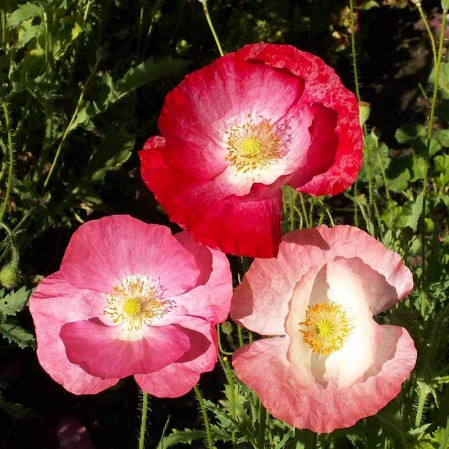Single Poppy Seed Mix
- HOW TO GROW
- FAST FACTS
- REVIEWS
HOW TO GROW
Sowing: Sow seeds in late fall or as soon as the soil can be worked in the spring. Plant just below the surface, lightly compacting the soil. Keep the soil consistently moist until germination, which usually occurs within 10-20 days. Do not attempt to move seedlings, since they resent having their roots disturbed.
Growing: Water seedlings occasionally until they become established. Mature plants tolerate drought fairly well, though they appreciate watering in dry weather. Do not move or divide the plants, since they do not transplant well. Deadhead faded blossoms for additional blooming. If seeds are not required, cut the plant back after blooming has finished. This plant often self-sows, and is highly attractive to bees, butterflies, and birds.
Harvesting: For cut flowers, choose stems with flowers that have just opened. Strip the foliage that will fall below the water level, and place in water immediately. For especially long-lasting blooms, sear the freshly cut ends with boiling water or a flame.
Seed Saving: After the flowers fade, small pods will form that eventually open at the top to reveal the ripe seeds. Gather the seeds as soon as the pods have opened; watch them carefully to prevent loss, since the seeds can easily be blown away by the wind. Store the seeds in a cool, dry place.
FAST FACTS
Latin Name: Papaver rhoeas
Species Origin: Introduced US Wildflower
Type: Garden Flowers
Life Cycle: Annual
USDA Zones: 1, 2, 3, 4, 5, 6, 7, 8, 9, 10, 11, 12
US Regions: California, Mountain, Arid/Desert, Plains/Texas, Midwest, Northern, Northeast, Southeast
Seeds per Ounce: 200,000
Stratification: No Stratification
Germination Ease: No Stratification
Sunlight: Full Sun, Part Sun
Height: 24 Inches
Color: Mixed, White, Pink, Red
Bloom Season: Blooms Early Summer, Blooms Late Summer
Uses: Cut Flowers, Deer Resistant
Huntington Beach Public Library Seed Library
The seeds arrived in a very timely manner. We are looking forward to adding this selection to our seed library.
Sow far sow good (get it?)
I ordered these too late to plant right now. I've found poppies do best for me when I sow the seeds either in the fall or early spring. If I can judge on the quick shipping speed and impressive packing of the shipment and the seeds, I anticipate a bumper crop. I will do my best to update next season. Thank you for the excellent service!
Delicate, delightful!
The tiny seeds require a careful hand but the spreading effect of the highly held fluttering petals will beckon you over in the garden. They make a perfect perch for that photo of your local butterfly population.
Poppies
Love the poppies. Would definitely order from them again.
Service & product are great
I was/am very impressed with the service and packaging of the poppy seed I purchased. I will definitely be purchasing from them again
DESCRIPTION
-Distribution-Map.gif)
HOW TO GROW
Sowing: Sow seeds in late fall or as soon as the soil can be worked in the spring. Plant just below the surface, lightly compacting the soil. Keep the soil consistently moist until germination, which usually occurs within 10-20 days. Do not attempt to move seedlings, since they resent having their roots disturbed.
Growing: Water seedlings occasionally until they become established. Mature plants tolerate drought fairly well, though they appreciate watering in dry weather. Do not move or divide the plants, since they do not transplant well. Deadhead faded blossoms for additional blooming. If seeds are not required, cut the plant back after blooming has finished. This plant often self-sows, and is highly attractive to bees, butterflies, and birds.
Harvesting: For cut flowers, choose stems with flowers that have just opened. Strip the foliage that will fall below the water level, and place in water immediately. For especially long-lasting blooms, sear the freshly cut ends with boiling water or a flame.
Seed Saving: After the flowers fade, small pods will form that eventually open at the top to reveal the ripe seeds. Gather the seeds as soon as the pods have opened; watch them carefully to prevent loss, since the seeds can easily be blown away by the wind. Store the seeds in a cool, dry place.
FAST FACTS
Latin Name: Papaver rhoeas
Species Origin: Introduced US Wildflower
Type: Garden Flowers
Life Cycle: Annual
USDA Zones: 1, 2, 3, 4, 5, 6, 7, 8, 9, 10, 11, 12
US Regions: California, Mountain, Arid/Desert, Plains/Texas, Midwest, Northern, Northeast, Southeast
Seeds per Ounce: 200,000
Stratification: No Stratification
Germination Ease: No Stratification
Sunlight: Full Sun, Part Sun
Height: 24 Inches
Color: Mixed, White, Pink, Red
Bloom Season: Blooms Early Summer, Blooms Late Summer
Uses: Cut Flowers, Deer Resistant
Reviews
Review
Huntington Beach Public Library Seed Library
The seeds arrived in a very timely manner. We are looking forward to adding this selection to our seed library.
Review
Sow far sow good (get it?)
I ordered these too late to plant right now. I've found poppies do best for me when I sow the seeds either in the fall or early spring. If I can judge on the quick shipping speed and impressive packing of the shipment and the seeds, I anticipate a bumper crop. I will do my best to update next season. Thank you for the excellent service!
Review
Delicate, delightful!
The tiny seeds require a careful hand but the spreading effect of the highly held fluttering petals will beckon you over in the garden. They make a perfect perch for that photo of your local butterfly population.
Review
Poppies
Love the poppies. Would definitely order from them again.
Review
Service & product are great
I was/am very impressed with the service and packaging of the poppy seed I purchased. I will definitely be purchasing from them again





